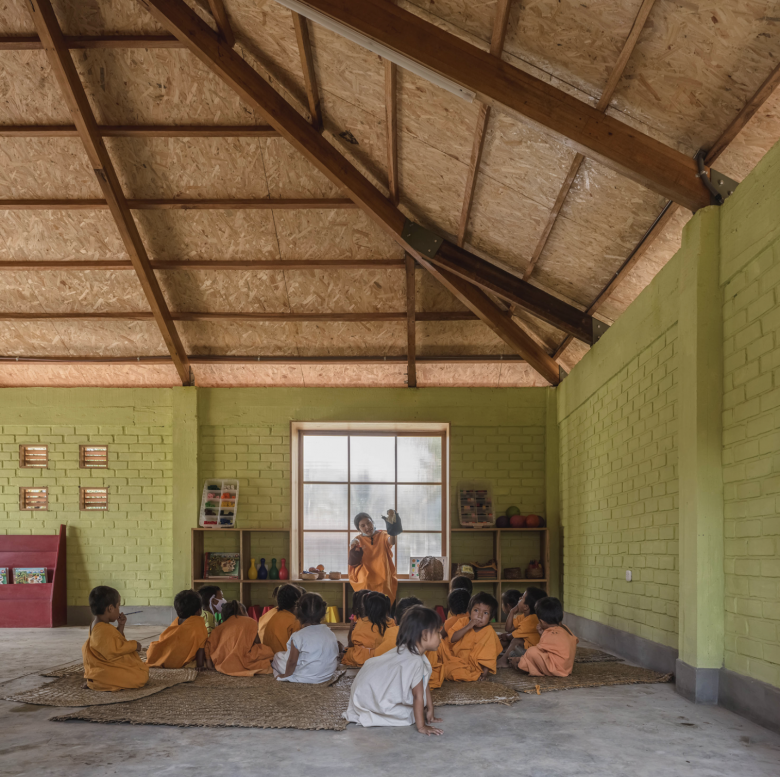With the Asociación Semillas, which she founded, Marta Maccaglia supports projects for educational buildings in the Peruvian Amazon region and builds schools in settlements near Lima, among other endeavors. For her great commitment, she has received the inaugural divia award — a prize that aims to give female architects more visibility.
When Marta Maccaglia traveled to Peru fresh out of college through an Italian government program, she originally wanted to work there as an educator. However, once on site she found a dilapidated daycare center. She decided to stay and rebuild the building with a local NGO. It is apt that the nonprofit Marta Maccaglia later founded is called Semillas, meaning “seeds.” Founded in 2014 and now based in the Peruvian cities of Lima, Junín, and Cajamarca, its members work to promote access to education and public infrastructure in places where it is far from a given.
"For me, education is the most important instrument for freedom. If we want a better society, we need an educated population."
With Semillas, the interior architect and exhibition designer has remained true to this approach. The now interdisciplinary team of national and international professionals — including architects, specialists in cooperative projects, builders, and craftspeople — has already built numerous schools and public facilities in the Peruvian jungle: a total of thirteen projects. Maccaglia has spent more than a decade working in Peru, researching the country's territories, cultures, and architectures, and has taught in the Faculty of Architecture at UCAL (Universidad de Ciencias y Artes de América Latina) since 2015.
"However, it is important to mention that our step-by-step method is only a guide that we carefully adjust for each project. It is a constant process — we have to free ourselves from our own prejudices."
For Maccaglia, it is problematic that the Peruvian government is trying to politically unify the country but is failing to include the indigenous communities in the microregions with their numerous languages. The government intends to build modern European buildings, but they do not correspond at all to the Peruvian mentality. The planners of Semillas, on the other hand, work with a participatory approach; they want to respect the country's diversity and incorporate the cultural wealth and knowledge of the people.
"Once the local people understood that we have no economic interests, they started to trust us. I am not a benevolent Italian — we exchange knowledge and benefit from these experiences because we learn something about their culture and they learn something about ours."
School buildings are important (and often the only) public buildings in a rural community. The creation of buildings in a joint process promotes exchange and understanding in a community. In addition, it is important to preserve knowledge, some of it thousands of years old, and to research the soil, the people, and their history. In the future, Maccaglia would like to continue developing projects in Peru and abroad that serve local communities. But she also finds it important to exert political influence on housing policy and to achieve multiplier effects through international cooperation with universities.
"We chose Marta Maccaglia as the award winner because we were impressed by the consistent architectural approach of her projects, which range from small to large, with each project also reflecting the local culture and characteristics of the site."
The jury, which had to select a winner from the five finalists, has chosen Marta Maccaglia as the first recipient of the divia award. "In her work in underserved areas, she creates buildings that can respond to the dynamic needs of the community with a generous spirit, a humanistic approach, and a courageous attitude," the citation reads. It also says that, since coming to Peru, Maccaglia has become an equal part of her adopted country.

divia award 2023
Edited by Ursula Schwitalla and Christiane Fath
Contributions by Veronika Lukashevich, Francesca Ferguson and Stella Lee
22 x 29 cm
92 Páginas
160 Illustrations
Hardcover
ISBN 9783775755252
Hatje Cantz
Purchase this book
The works of the finalists can be seen in an exhibition at Architekturforum Aedes in Berlin from May 7 to 14. In addition, a publication will be published by Hatje Cantz Verlag. The finale of this year's edition of the divia awards will be a celebration at Palazzo Contarini Polignac during the opening week of the 18th Venice Architecture Biennale.
This article was first published as “Marta Maccaglia ausgezeichnet” on German-Architects. English translation edited by John Hill.



